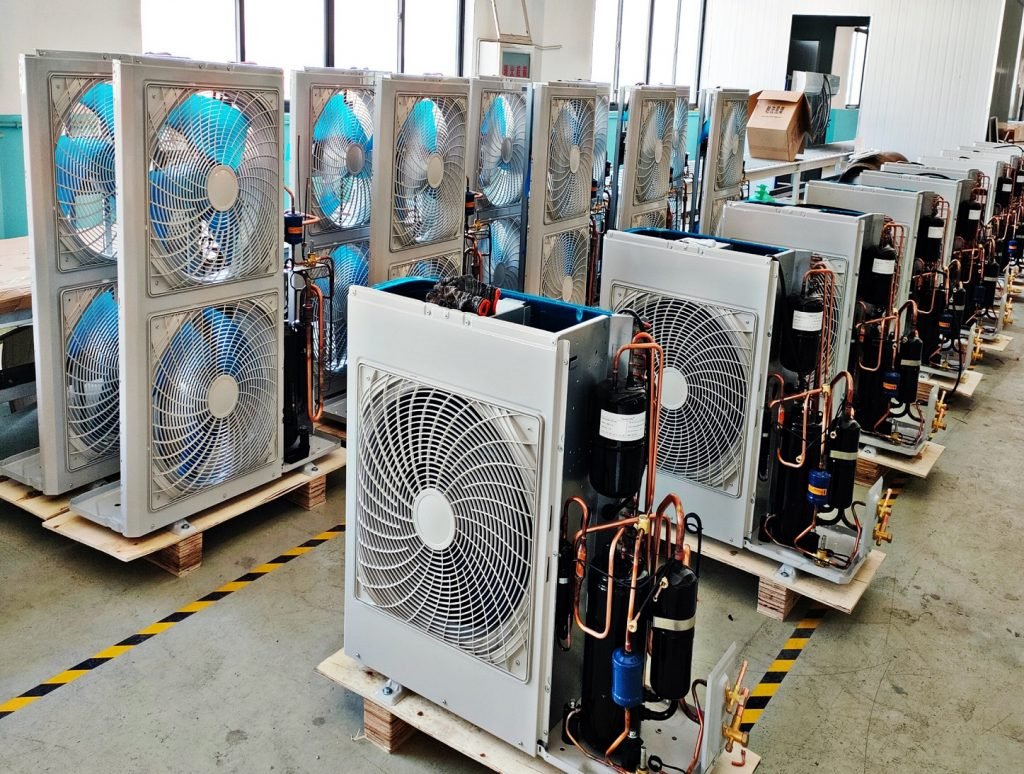Refrigeration system is a complex cycle system composed of key components such as compressor, condenser, expansion valve, and evaporator. These components work together to achieve cooling through circulation of the refrigerant.
However, when air enters this closed system, it can cause series problems that affect its normal operation. Therefore, it is crucial to understand the causes, distribution, hazards, and removal methods of air intrusion in refrigeration systems.
Causes of Air in Refrigeration System
Although refrigeration systems are sealed cycles where air should not enter, air may still infiltrate due to various reasons.
Below is a detailed analysis of these causes:
1.Incomplete Vacuuming During Installation or Maintenance
–Vacuuming is critical for removing air and moisture during installation or maintenance. Poor vacuum pump performance or insufficient vacuuming time can leave air in the system.
–Inexperienced operators or equipment issues may also result in incomplete vacuuming.
2. Air Introduced During Refrigerant Addition
–Improper procedures, such as unsealed refrigerant containers or incorrectly connected hoses, can allow air to enter the system during refrigerant addition.
–Open filling methods increase the likelihood of air entering.
3. System Leakage
–Leakage points in the system can let air in, particularly if both the high & low pressure sides have leaks. Pressure differences facilitate air intrusion.
–Leakage often occurs at pipe connections, valve seals, or compressor seals.
4. Use Substandard Refrigerants or Unsealed Containers
–Substandard refrigerants may contain impurities or moisture, introducing air into the system.
–Poorly sealed containers allow air to mix with refrigerants and subsequently enter the system.
5. Lack of Air Removal During Long-Term Operation
–Over time, air may slowly infiltrate the system, especially with significant pressure fluctuations.
–Operator negligence or malfunctioning air removal equipment can result in air accumulation.
6. Atmospheric Air Penetration
If the system’s operating pressure is lower than atmospheric pressure, air can seep into the system through gaps in valves, compressors, or non-welded connections.
7. Decomposition of Lubricating Oil
Some lubricating oils, such as mineral oils, can decompose under complex working conditions, releasing hydrocarbons that mix with the refrigerant.
Distribution of Air in Refrigeration System
1. Natural Accumulation Locations
Air is lighter than refrigerants and tends to accumulate at high points in the system, such as:
Condenser: Often installed at a high position in the system, making it a common air accumulation point.
Receiver: Another high point where air easily gathers.
Accumulator: Certain systems see air accumulating here.
High Sections of Pipes: Any elevated pipe section can become a location for air accumulation.
2. Air Movement in the System
Air can dissolve in the refrigerant and move through the system during operation, affect various components.
3. System Design Impact on Air Distribution
—Complex Piping Layouts: Increase potential areas for air accumulation.
—Height Differences: Large height variations in the system may lead to concentrated air at higher points.
Hazards of Air in Refrigeration System
1. Increase Energy Consumption
Air consists mainly of nitrogen and oxygen, which are non-condensable gases. Air accumulation in the high-pressure side raises system pressure, force the compressor to work harder, increase energy consumption and wear, and shorten the compressor’s lifetime.
2. Induce Chemical Reactions
Moisture in the air can react with refrigerants, especially in mineral oil systems, producing acidic substances that corrode internal metal components, leading to leaks and damage.
3. Reduce Cooling Efficiency
Air in the condenser or evaporator can cause “air locks,” obstructing refrigerant flow and heat exchange, reduce overall system efficiency.
4. Form Ice Block
Moisture in the air may freeze at throttling devices (e.g., expansion valves), causing blockages that disrupt refrigerant flow and can damage equipment.
5. Impair Expansion Valve Performance
Air presence may distort pressure readings at the expansion valve, lead to improper regulation and unstable refrigerant flow.
6. Compressor Lubrication Issues
Moisture in the air can degrade lubricating oil, reduce its effectiveness and cause compressor wear or failure.
Methods to Remove Air from Refrigeration System
1. Use System-Designed Air Release Mechanisms
Many refrigeration systems have automatic venting devices, such as vent valves located at the top of the condenser. These devices can automatically expel air during system operation. To utilize these devices for venting:
Locate air release valves: Often on the condenser’s highest point.
Manual Release: Open the valve slowly during operation to release air while monitoring pressure gauges to avoid refrigerant loss.
2. Vacuum Extraction Method
Use vacuum pump to evacuate the system can effectively remove air and moisture.
Prepare Vacuum Pump: Select a vacuum pump suitable for the system’s capacity and ensure it is in good working condition.
Connect Vacuum Pump: Attach the vacuum pump to system’s vacuum port.
Evacuation Process: Start the vacuum pump and continue evacuation until the system pressure reaches the specified vacuum level. It is usually necessary to maintain this level for a while to ensure thorough removal of air and moisture.
Check the Vacuum Level: Use a vacuum gauge to monitor the vacuum level and ensure it meets the technical requirements.
3. Manual Air Release
When the system is in a shutdown state, manually open the vent valve to release air.
Locate the Vent Valve: Identify the vent valve in the system, normally located at the high point.
Slowly Open the Valve: Gradually open the vent valve to release air. Monitor the refrigerant flow to avoid significant refrigerant loss.
Repeat Venting: Made multiple venting operations until no bubbles appear.
4. High-Temperature Air Release
By increasing the system temperature, the moisture in the air evaporates, and then the air is expelled.
Heat the System: Use heating equipment to raise the system temperature, causing the moisture to evaporate.
Vent the Air: Under high-temperature conditions, expel air and water vapor through the vent valve.
Cool the System: After the system cools down, check for any remaining air.
5. Use Desiccants
Add desiccants to the system to absorb moisture and reduce the air impact.
Select the Desiccant: Use desiccants suitable for the type of refrigerant, such as molecular sieves.
Install the Dryer: Install a dryer in the system and replace the desiccant regularly.
6. Preventative Measures
Regularly Check for Leaks: Periodically inspect the system’s sealing to prevent air ingress.
Properly Add Refrigerant: When adding refrigerant, ensure the container is sealed to avoid air mixing.
Maintain Sealing Integrity: During maintenance and installation, ensure all connections are properly sealed.
7. Safety and Environmental Precautions
Wear Protective Gear: During venting operations, wear protective gloves and goggles to prevent refrigerant cold burns.
Prevent Refrigerant Leaks: Adhere to environmental regulations to prevent refrigerant leaks that could harm the environment.
Use Professional Tools: Ensure use of appropriate tools and equipment for venting operations.
8. Verify Venting Effectiveness
Pressure Test: Monitor system pressure using a pressure gauge to ensure stability.
Observe Operating Status: After system operation, observe the cooling effect and compressor performance to ensure no abnormalities.
9. Common Issues
System Still Not Cooling: This may indicate residual air or other faults, requiring re-venting or further troubleshooting.
Pressure Abnormalities: Check for system leaks or desiccant failure.
Conclusion
Air ingress in refrigeration systems is a significant issue that can’t be ignored, as it not only affects system efficiency but may also shorten equipment lifespan. Air can enter the system during installation, maintenance, leaks, or refrigerant charging, primarily accumulating in high areas such as condensers or near expansion valves. This leads to reduced efficiency, compressor damage, blockages, and pressure imbalances.
To solve this issue, this article introduces various methods for removing air, including using the system’s vent valves, manual venting, vacuum venting, high-temperature venting, and using desiccants to absorb moisture. Additionally, preventive measures such as regular leak checks, proper refrigerant charging, and maintaining system sealing are crucial.
In summary, timely remove air from the system is essential for maintaining efficient operation and extending equipment lifetime. While multiple methods are available for air removal, prevention remains key. Through regular maintenance and proper installation practices, can ensure the system smooth operation.
For system operators, vigilance against air ingress and taking appropriate measures are critical to ensure the long-term stable operation of refrigeration systems. These methods and preventive measures not only improve efficiency but also save on maintenance costs in the long run.
Any comments?
Welcome leave a message or repost.













